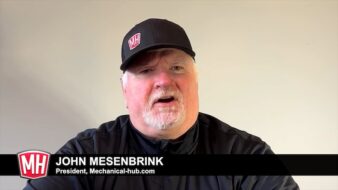That’s not the name of a southern rock band, but it could be.
It would also make a great name for a project that Kelleher Heating and Cooling took on recently, just outside of Richmond, Va.
Dating back to the 1700s, the historic Brook Hill estate has been home to dozens of Virginia dignitaries, and has always been under the careful watch of a family descendant.

The 11,000-sq.-ft. plantation home, built in 1850, served as a Confederate field hospital. The basement was the final resting place of several slaves, and Route 1 used to run directly through the property.
It sounds a bit spooky, and looks the part, too. But despite the gothic mansion’s towering profile and dark colors, its sole inhabitant swears that the only frightening occurrence in recent years has been the arrival of the oil bill.
In heating season, the drafty old mansion generally consumed 1,000 gallons of fuel oil each month. Rated at 5 GPH each, two old boilers heat the home. One of the boilers had just recently sprung a leak, too.

From l to r: Cory Sandlin, apprentice plumber, Dennis Shiflett, master plumber, Lonnie Herman, master plumber, Peter Grainger, plumbing sales (master plumber), Tom Crampton, master plumber, Chuck Greenberg, plumbing, A/C and electrical supervisor.
While the drivers at Kelleher Heating and Cooling were happy to deliver the #2, Pete Grainger, estimator at the 40-person company, had suggested for years to retrofit with a natural gas system. After two rough winters in a row, the estate took him up on it in 2015.
System design began in the spring. The plan was to change the living space as little as possible; just add new T-stats. A dozen or more fireplaces were the original source of heat. Sometime in the past half-century, hydronic wall registers, fin-tube baseboard and a little cast iron had been added to create two big zones.
Trading high mass for low mass
The Kelleher crew went into demolition mode in late August. Lonnie Herman, who’s been with Kelleher for 20 of its 50 years, was lead installer on the job. He was joined by Dennis Shiflett, Tom Crampton, Chuck Greenberg and Cory Sandlin.

The oil tanks were hauled out and the two massive boilers were broken apart. One of the big units had recently developed a leak. At the same time, RE Michel delivered the two new, 95 percent efficient Burnham Alpine 399 boilers. The utility ran a gas line several hundred yards to the mansion, at which point Kelleher took over and continued for another 40 feet.
“The install was pretty straightforward,” continued Greenberg. “We piped and wired the boilers in a lead-lag configuration so that we have a 10-to-one turndown. The system can provide anywhere from 80,000 to nearly 800,000 BTUs. That’s a major asset here.”
 But there was another big advantage to pairing condensing boilers with the old hydronic system: the two giant zones made for big temperature differentials and long condensing cycles. Generally, the downside to a big Delta T on a fin-tube system is a slight temperature variation across the different rooms on any given zone. But most of the mansion is uninhabited, so slight temperature variance is of little concern.
But there was another big advantage to pairing condensing boilers with the old hydronic system: the two giant zones made for big temperature differentials and long condensing cycles. Generally, the downside to a big Delta T on a fin-tube system is a slight temperature variation across the different rooms on any given zone. But most of the mansion is uninhabited, so slight temperature variance is of little concern.
Given then old piping and radiation throughout the house, three Y-strainers were included on the new piping. The only real challenge was venting. The Kelleher techs ran pipe 35 feet to reach a suitable area. The thick stone and brick foundation took a while to break, though. The job wrapped up about two weeks after it began.
Lots of improvements
“This was only the second time I’ve installed an Alpine,” said Greenberg. “We’ve used Burnham’s cast-iron boilers for decades, and I really wanted to try the Alpine in a dual-boiler setup. The controls are friendlier than what we’re used to on a condensing boiler, and the support was fantastic.”
Throughout the project, Kelleher worked with Ron Beck at US Boiler Company, RE Michel Company, and Cindy Lau at ROI Marketing if a question came up.

With all that new stainless steel in the basement, it would’ve been a shame not to get rid of the old LP-fired, 80-gallon water heater. Kelleher installed a 50-gallon Burnham Alliance indirect tank as a third zone off the main loop.
“Most folks have no concept of what it takes to keep a place like this this intact,” said the anonymous caretaker with a smile in her voice. “With the new heating system, it’ll be a little bit easier.”
Components:
Two Alpine 399
Alliance 50-gallon
Taco Zone Controller
Taco 0014-30 Circulators
2″ Spirovent Air Separator
Two 1 1/2″ Strainers, One 2″ Strainer (Legend)
Amtrol SX-90 Expansion
Amtrol ST12 Potable Expansion
Maxitrol Regulators with Vent Limitera
4″ CPVC Vent Pipe
Zoned with 0014 Circulators and Check Valves
Standard Outdoor Reset




Join the conversation: